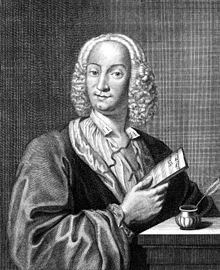Music
The concerto is structured in three movements: [6]
- Allegro
- Largo
- Allegro
The first movement begins not with the usual instrumental ritornello, but with the two soloists alone, imitating each other in fast succession, [2] with virtuoso passages. [6] [2] Both soloists are equals, first competing without upper strings. [6] Karl Heller noted that "the dark color of the two deep-toned instruments perfectly matches the serious expression, which is devoid of all virtuosity". [7] He continued:
The most striking aspect of the first movement (Allegro) is the wholly individual organizational approach that Vivaldi took in the opening. The two cellos imitate each other at a distance of one bar; they then play for the rest of the movement at an interval of a third, and play eight bars of figuration over the continuo's G minor harmony." [7]
In the second movement, marked Largo, the two soloists and the continuo cellist form a trio, for even greater low-range sonority. [6]
The final movement, Allegro, begins with "catchy offbeat syncopations" in the orchestra, before the soloists enter for "musical acrobatics". [6] The movement contains a fugal section begun by the second cello. [2]
The musicologist Michael Talbot noted the concerto's "highly charged emotional content" showing right at the beginning, and read "an almost autobiographical sadness" in the slow movement. He found the "frenetic" finale "see-sawing in rhythm and tonality alike", and summarized: "This is a concerto to single out among the hundreds that Vivaldi wrote." [4]
This page is based on this
Wikipedia article Text is available under the
CC BY-SA 4.0 license; additional terms may apply.
Images, videos and audio are available under their respective licenses.
